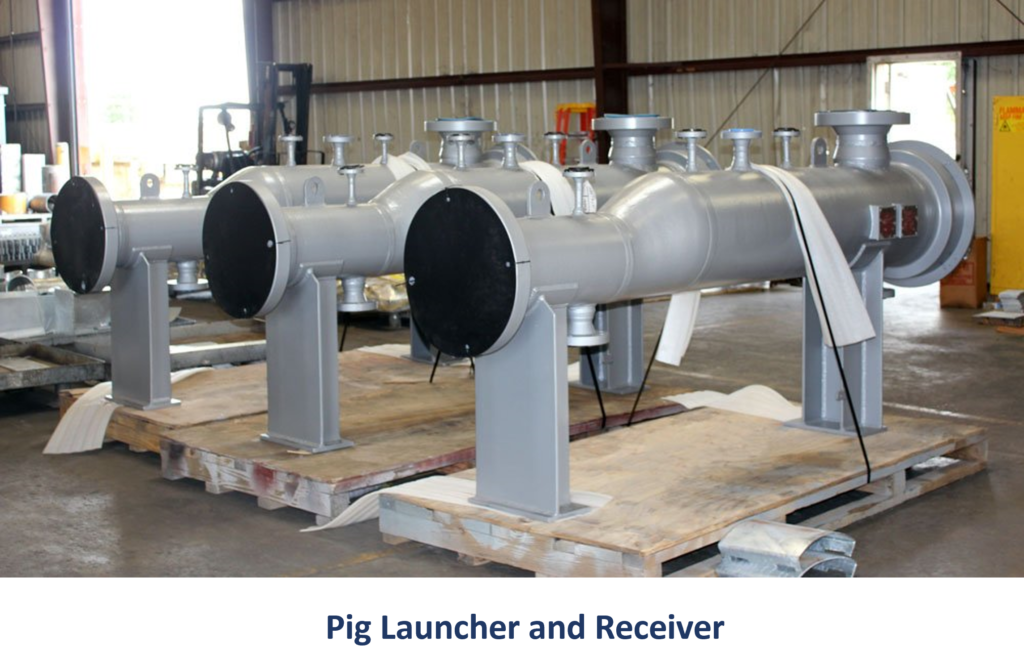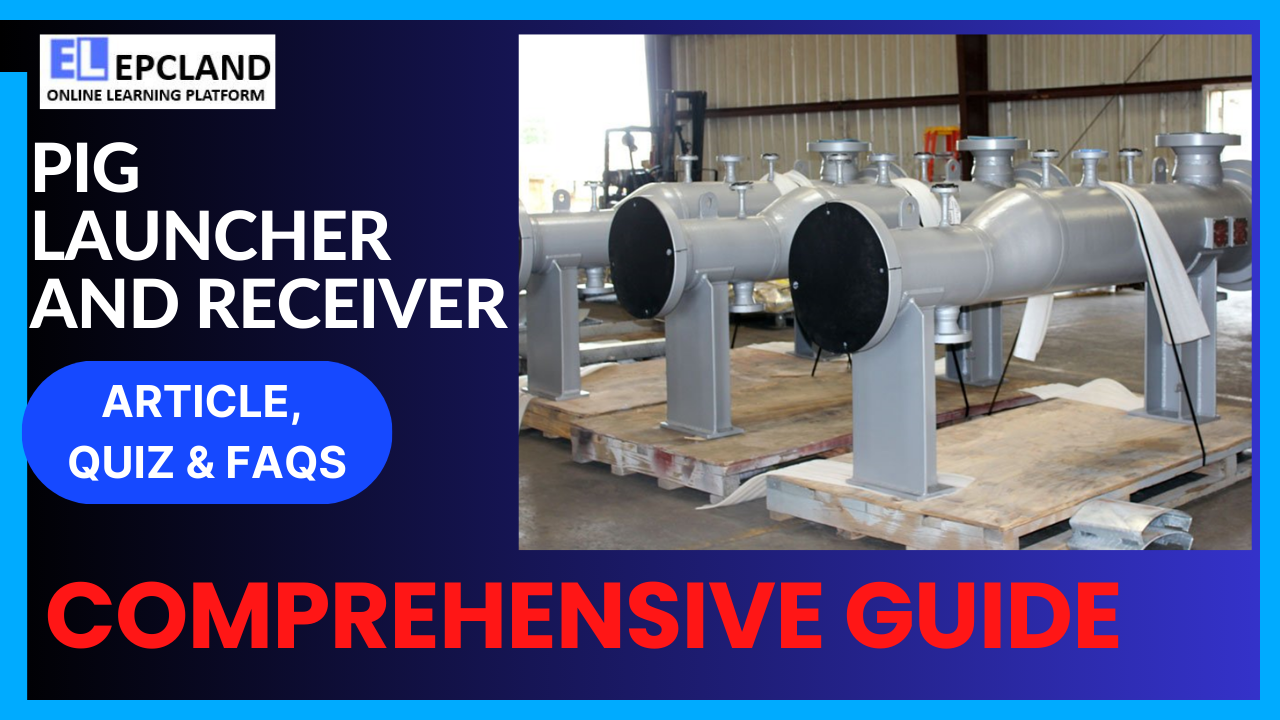I. Introduction
The oil and gas industry is marked by its complex network of pipelines that transport valuable hydrocarbons over vast distances. Maintaining the integrity and efficiency of these pipelines is paramount. One essential component in this endeavor is the Pig Launcher and Receiver system. In this article, we delve into the significance, history, working principles, types, applications, advantages, disadvantages, and relevant codes and standards associated with Pig Launchers and Receivers.
Table of Contents
Don’t miss the Complete Course on Piping Engineering: Check Now
Enrollment Link
II. Brief History
Pig Launchers and Receivers have a rich history dating back to the early days of the oil and gas industry. Originally, the term “pig” referred to a cylindrical cleaning device that made squealing sounds as it moved through pipelines, akin to a pig. Over time, these devices evolved from simple cleaning tools to versatile systems for inspection, cleaning, and maintenance.
III. Basic Function & Working Principle of Pig Launcher and Receiver
Pig Launchers and Receivers are essential components of pipeline systems in the oil and gas industry. They play a crucial role in the maintenance, cleaning, and inspection of pipelines. These systems are designed to safely and efficiently launch and receive pipeline cleaning and inspection devices, often referred to as “pigs.”
A. Pigging in Pipelines
Pigging is a fundamental process in pipeline management that involves the use of a pig, which is a cylindrical or spherical tool, to perform various tasks inside a pipeline. Pigs are typically inserted into a pipeline through a Pig Launcher and retrieved at the other end using a Pig Receiver. Here’s a detailed breakdown of the basic functions and working principles of both components:
B. Pig Launcher: Function and Working Principle
1. Storage and Launching of Pigs
The Pig Launcher is essentially a pressure vessel equipped with a closure at one end. Its primary function is to store and launch the pig into the pipeline. Here’s how it works:
- Pig Storage: Before a pigging operation begins, the launcher is pressurized and sealed. The pig is loaded into the launcher through an access door or opening.
- Launching: When the pigging operation is initiated, a valve at the downstream end of the launcher is opened, allowing the product (e.g., crude oil, natural gas) to flow into the launcher. The pressure buildup inside the launcher propels the pig into the pipeline.
2. Pressure Control and Safety
Safety is paramount in pigging operations. To ensure safe pig launching, the launcher is equipped with safety features:
- Pressure Relief: Pressure relief devices are installed to prevent over-pressurization of the launcher, ensuring that it operates within safe limits.
- Isolation Valves: Isolation valves are used to control the flow of product into the launcher and isolate it when necessary, such as during maintenance or pig replacement.
C. Pig Receiver: Function and Working Principle
1. Pig Retrieval
The Pig Receiver is located at the downstream end of the pipeline and serves as the collection point for the pig after it has completed its journey through the pipeline. Here’s how it works:
- Pig Arrival: As the pig approaches the receiver, it slows down due to the decreasing pressure in the pipeline.
- Pig Capture: The receiver is equipped with a closure, often in the form of a closure door or a sphere, which captures the pig as it enters the receiver. The closure prevents the pig from continuing downstream.
2. Isolation and Product Separation
Once the pig is captured, the receiver isolates it from the product flow and allows for separation:
- Isolation: The closure in the receiver seals off the pig from the pipeline, preventing any further flow of product into the receiver.
- Product Separation: The separated product can be diverted to a separate pipeline or storage tank, while the pig remains isolated for inspection, cleaning, or maintenance.
D. Pigging for Different Purposes
The specific function of Pig Launchers and Receivers can vary depending on the purpose of the pigging operation:
- Cleaning: In cleaning operations, pigs are equipped with brushes, scrapers, or magnets to remove debris, wax, and contaminants from the pipeline walls.
- Inspection: Inspection pigs are equipped with sensors, cameras, or other instruments to assess the condition of the pipeline, identifying issues like corrosion, cracks, or irregularities.
- Maintenance: Some pigs are designed for maintenance tasks, such as applying protective coatings to the pipeline interior or mitigating corrosion.
Don’t miss the Complete Course on Piping Engineering: Check Now
Enrollment Link
IV. Types of Pig Launchers and Receivers
A. Barrel Launchers and Receivers
These are the most common types, consisting of a cylindrical pressure vessel that contains the pig. They are typically used for cleaning, maintenance, and inspection.
B. Sphere Launchers and Receivers
Spherical launchers and receivers are designed for high-pressure applications and are more compact than barrel types. They are often used in offshore pipelines.
C. Bi-Directional Launchers and Receivers
These are versatile systems that can launch and receive pigs in both directions, making them suitable for pipelines with bidirectional flows.

V. Applications of Pig Launchers & Receivers
Pig Launchers and Receivers are versatile components that find applications across different stages of the oil and gas industry’s pipeline infrastructure. Their primary purpose is to ensure the integrity, efficiency, and safety of pipelines by performing various tasks, including cleaning, inspection, and maintenance. Here are the key applications:
A. Cleaning
1. Debris Removal: One of the primary applications of Pig Launchers and Receivers is pipeline cleaning. Over time, pipelines can accumulate debris, sediment, scale, and wax deposits, which can impede the flow of hydrocarbons. Cleaning pigs, equipped with brushes, scrapers, or other cleaning mechanisms, are launched into the pipeline to remove these contaminants, restoring optimal flow conditions.
2. Paraffin and Wax Removal: In oil pipelines, paraffin and wax buildup is a common issue. Specialized pigs, known as wax pigs or paraffin pigs, are designed to scrape off and remove these deposits, preventing flow restrictions and blockages.
3. Corrosion Control: Corrosion is a significant concern in the oil and gas industry. Corrosion control pigs are used to apply inhibitors and coatings to the interior of pipelines, protecting them from corrosion and extending their lifespan.
B. Inspection
1. Inline Inspection (ILI): Pigging systems are equipped with intelligent pigs that can perform inline inspections of pipelines. These inspection pigs are equipped with sensors, cameras, and data recording equipment. They move through the pipeline, capturing critical data on the condition of the pipeline wall, welds, and any anomalies. This data helps operators identify potential issues such as corrosion, cracks, and dents.
2. Ultrasonic Testing: Some pigs are equipped with ultrasonic sensors to detect wall thickness variations and pinpoint areas of corrosion or wear. Ultrasonic testing is particularly valuable for assessing the structural integrity of pipelines.
3. Magnetic Flux Leakage (MFL): MFL pigs use magnetic fields to detect anomalies in the pipeline’s metal wall. They are effective at identifying areas with metal loss due to corrosion.
C. Maintenance
1. Coating Application: Pigging systems can be used to apply protective coatings to the interior of pipelines. Coating pigs are equipped with brushes or spray systems that evenly distribute protective coatings, such as epoxy or polyurethane, to prevent corrosion and extend the pipeline’s life.
2. Pipeline Gauging: Gauging pigs are used to measure the internal diameter of the pipeline. This helps ensure that the pipeline remains within its specified tolerances and can accommodate various types of pigs.
3. Batch Tracking: In batch processing or multiproduct pipelines, tracking pigs are used to separate different products or batches. These pigs contain RFID or other tracking devices to monitor the movement of specific products within the pipeline.
D. Emergency Response
1. Blockage Removal: In the event of a pipeline blockage or pig stuck in the line, specialized pigs known as “pilot pigs” can be used to push or pull the stuck pig out of the pipeline, restoring flow.
2. Pipeline Isolation: Pigging systems can also be used to isolate sections of the pipeline in case of emergencies or maintenance activities. This can help prevent the release of hazardous materials in the event of a rupture or other incidents.
E. Efficiency Enhancement
1. Flow Assurance: By regularly cleaning and inspecting pipelines, Pig Launchers and Receivers contribute to flow assurance, ensuring that hydrocarbons can be transported efficiently and without interruption.
2. Product Quality: In the case of multiproduct pipelines, the use of pigs ensures that different products do not mix, preserving product quality and reducing contamination risks.
3. Reduced Maintenance Downtime: Proactive maintenance using pigging systems can reduce the need for costly and time-consuming pipeline shutdowns.
VI. Advantages & Disadvantages
Advantages of Pig Launchers & Receivers
| Advantage | Description |
|---|---|
| 1. Enhanced Pipeline Integrity | Regular pigging helps prevent corrosion and damage to pipelines. |
| 2. Efficient Cleaning and Inspection | Pigs ensure pipelines remain free from blockages and contaminants. |
| 3. Versatility | Suitable for a wide range of pipeline types and applications. |
| 4. Improved Safety | Regular inspections help identify potential issues before they become critical. |
Don’t miss the Complete Course on Piping Engineering: Check Now
Enrollment Link
1. Enhanced Pipeline Integrity:
- One of the primary advantages of using Pig Launchers and Receivers is the enhancement of pipeline integrity. Regular pigging operations help prevent corrosion, scaling, and the buildup of contaminants inside pipelines. This contributes to the long-term reliability and safety of the pipeline infrastructure.
2. Efficient Cleaning and Inspection:
- Pigging systems are highly effective in cleaning pipelines. They remove debris, sediment, wax, and other deposits that can impede the flow of hydrocarbons. This efficient cleaning process helps maintain optimal pipeline efficiency.
3. Versatility:
- Pig Launchers and Receivers are versatile and can be used in various types of pipelines, including those for crude oil, natural gas, refined products, and petrochemicals. They are also adaptable to different pipeline sizes and configurations.
4. Improved Safety:
- Pigging plays a crucial role in pipeline safety. Regular inspections using smart pigs equipped with sensors and cameras can identify potential issues such as corrosion, cracks, or weld defects before they become critical. This proactive approach helps prevent pipeline failures and accidents.
5. Environmental Benefits:
- Efficient pigging reduces the risk of spills and leaks, minimizing the environmental impact of pipeline operations. By maintaining clean and well-maintained pipelines, the industry can reduce the likelihood of environmental incidents.
Disadvantages of Pig Launchers & Receivers
| Disadvantage | Description |
|---|---|
| 1. Costly Equipment | Installing and maintaining pigging systems can be expensive. |
| 2. Operational Complexity | Requires skilled personnel and precise coordination. |
| 3. Downtime | Pigging operations may require temporary shutdowns. |
1. Costly Equipment:
- The installation and maintenance of Pig Launchers and Receivers can be expensive. These systems require specialized components, including pressure vessels, valves, and actuators, which can result in significant upfront costs.
2. Operational Complexity:
- Pigging operations require skilled personnel who understand the intricacies of the equipment and the pipeline system. Proper coordination is necessary to ensure the safe and effective launch, travel, and reception of pigs.
3. Downtime:
- Pigging operations often necessitate temporary shutdowns of the pipeline, which can disrupt the continuous flow of hydrocarbons. This downtime can lead to production losses and reduced revenue.
4. Maintenance Challenges:
- While Pig Launchers and Receivers contribute to pipeline maintenance, they themselves require regular maintenance to ensure their proper functioning. Maintenance can be complex and costly, adding to the overall operational expenses.
5. Pigging Constraints:
- Not all pipelines are suitable for pigging. Some pipelines, especially those with complex geometries or tight bends, may pose challenges for pigging operations. In such cases, alternative methods may be required for maintenance and inspection.
VII. Associated Codes & Standards
The oil and gas industry adheres to strict codes and standards to ensure the safe and reliable operation of Pig Launchers and Receivers. Some relevant ones include:
A. ASME B31.4 and ASME B31.8
These codes govern the design, construction, and inspection of pipelines and associated facilities.
B. API RP 2201
This API recommended practice provides guidelines for safe pigging operations, including the design and operation of pigging facilities.
VIII. Conclusion
Pig Launchers and Receivers are indispensable tools in the oil and gas industry, contributing to the safe and efficient operation of pipelines. Their evolution from simple cleaning devices to multifunctional systems reflects the industry’s commitment to innovation and reliability. By adhering to stringent codes and standards, companies ensure the integrity of their pipelines, mitigating risks and maximizing productivity.
In conclusion, as the oil and gas industry continues to expand and evolve, Pig Launchers and Receivers remain at the forefront of maintaining pipeline integrity, safeguarding the environment, and sustaining the world’s energy needs.
FAQs
1. What is the purpose of Pig Launchers and Receivers in pipelines?
- Pig Launchers and Receivers are crucial components in pipeline systems used for various purposes, including cleaning, inspection, and maintenance. They facilitate the launching and receiving of pipeline inspection gauges (pigs), which help ensure the integrity and efficiency of pipelines.
2. How do Pig Launchers and Receivers work?
- Pig Launchers store and release pigs into the pipeline. These pigs are then propelled through the pipeline by the product flow, performing tasks such as cleaning or inspection. Pig Receivers capture the pigs at the pipeline’s end, allowing for their safe removal.
3. What are the different types of Pig Launchers and Receivers, and when are they used?
- There are several types of Pig Launchers and Receivers, including barrel, sphere, and bi-directional designs. Barrel Launchers and Receivers are commonly used for cleaning, maintenance, and inspection. Spherical Launchers and Receivers are suitable for high-pressure applications, while bi-directional systems can launch and receive pigs in both directions, making them versatile for bidirectional pipelines.
4. What are the advantages of using Pig Launchers and Receivers in pipeline operations?
- Pig Launchers and Receivers offer several benefits, such as enhancing pipeline integrity by preventing corrosion and blockages, efficiently cleaning and inspecting pipelines, versatility for different applications, and improving safety by identifying potential issues before they become critical.
5. Are there any disadvantages or challenges associated with Pig Launchers and Receivers?
- While Pig Launchers and Receivers are valuable tools, they can be costly to install and maintain. Their operation can also be complex, requiring skilled personnel and precise coordination. Additionally, pigging operations may necessitate temporary pipeline shutdowns, leading to downtime.
Recommended courses (Published on EPCLand)
- Basics of Piping Engineering
- Piping Layout Engineering
- Piping Material Engineering
- Piping Stress Analysis
- Complete Course on Piping Engineering
- Material Requisitions
- Piping Material Specifications
- Valve Material Specifications
Don’t miss the published articles on following:
Don’t miss the Complete Course on Piping Engineering: Check Now
Enrollment Link
Attempt Quiz
Question 1:
What is the primary purpose of a Pig Launcher in the Oil & Gas Industry?
Explanation: A Pig Launcher is used to launch pigs (devices) into pipelines for cleaning and inspection purposes in the Oil & Gas Industry.
Question 2:
What is the primary purpose of a Pig Receiver in pipeline systems?
Explanation: A Pig Receiver is designed to receive and collect pigs (devices) after they exit the pipeline, typically following cleaning or inspection activities.
Question 3:
What are “pigs” in the context of the Oil & Gas Industry?
Explanation: In the context of the Oil & Gas Industry, “pigs” refer to devices used for cleaning, inspecting, and maintaining pipelines.
Question 4:
Why is it important to use Pig Launchers and Receivers in pipeline systems?
Explanation: Pig Launchers and Receivers are used to improve pipeline safety and efficiency by facilitating cleaning, inspection, and maintenance activities.
Question 5:
Which type of pig is commonly used for cleaning pipelines?
Explanation: Foam pigs are commonly used for cleaning pipelines in the Oil & Gas Industry.
Question 6:
What is the primary material used for constructing Pig Launchers and Receivers?
Explanation: Steel is the primary material used for constructing Pig Launchers and Receivers due to its strength and durability.
Question 7:
Which part of the pigging process involves the use of Pig Launchers?
Explanation: Pig Launchers are used for launching pigs into the pipeline during the pigging process.
Question 8:
What is the purpose of a Pig Trap in pipeline systems?
Explanation: A Pig Trap is designed to provide access for maintenance and pig retrieval in pipeline systems.
Question 9:
What is the typical purpose of pigging in gas pipelines?
Explanation: Pigging in gas pipelines is primarily used to remove contaminants, scale, and debris to maintain pipeline integrity.
Question 10:
What is the main advantage of using pigs in pipeline maintenance?
Explanation: The main advantage of using pigs in pipeline maintenance is enhanced pipeline safety and efficiency through cleaning and inspection.



